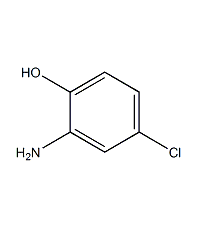2-amino-4-chlorophenol

Structural formula
| Business number | 02A1 |
|---|---|
| Molecular formula | C6H6ClNO |
| Molecular weight | 143.57 |
| label |
5-Chloro-2-hydroxyaniline, o-amino-p-chlorophenol, 2-amino-4-chlorophenol, 4-Chloro-2-aminophenol, p-Chloro-o-aminophenol, 2-hydroxy-5-chloroaniline, 4-Chloro-2-aminophenol, 5-Chloro-2-hydroxyaniline, H2NC6H3(Cl)OH, 4-Chloro-2-aminophenol, p-Chloro-o-aminophenol, 5-Chloro-2-hydroxyaniline |
Numbering system
CAS number:95-85-2
MDL number:MFCD00007694
EINECS number:202-458-9
RTECS number:SJ5700000
BRN number:774859
PubChem number:24892694
Physical property data
1. Appearance: White flaky crystal
2. Density (g/mL, 25/4℃): Undetermined
3. Relative vapor density (g/mL , air=1): Undetermined
4. Melting point (ºC): 140~141
5. Boiling point (ºC, normal pressure): Undetermined
6. Boiling point (ºC, 5.2kPa): Undetermined
7. Refractive index: Undetermined
8. Flash point (ºC): Undetermined
9. Specific rotation (º): Undetermined
10. Autoignition point or ignition temperature (ºC): Undetermined
11. Vapor pressure (kPa, 25ºC): Undetermined
12. Saturated vapor pressure (kPa, 60ºC): Undetermined
13. Heat of combustion (KJ/mol): Undetermined
14. Critical temperature (ºC): Undetermined
15. Critical pressure (KPa): Undetermined
16. Log value of oil-water (octanol/water) partition coefficient: Undetermined
17. Explosion upper limit (%, V/V): Undetermined
18. Explosion lower limit (%, V/V): Undetermined
19. Solubility: Easily soluble in hot water, soluble in ethanol, ether, dilute acid and dilute alkali.
Toxicological data
1. Acute toxicity: Rat oral LD50: 690mg/kg; Mouse oral LD50: 1030mg/kg;
2. Mutagenicity
Microbial typhoid fever Salmonella mutation: 333μg/plate;
Ecological data
None yet
Molecular structure��Data
1. Molar refractive index: 37.26
2. Molar volume (cm3/mol): 102.0
3. Isotonic specific volume (90.2K ): 283.9
4. Surface tension (dyne/cm): 59.8
5. Dielectric constant:
6. Dipole moment (10-24cm3):
7. Polarizability: 14.77
Compute chemical data
1. Reference value for hydrophobic parameter calculation (XlogP): None
2. Number of hydrogen bond donors: 2
3. Number of hydrogen bond acceptors: 2
4. Number of rotatable chemical bonds: 0
5. Number of tautomers: 5
6. Topological molecule polar surface area 46.2
7. Number of heavy atoms: 9
8. Surface charge: 0
9. Complexity: 99.1
10. Number of isotope atoms: 0
11. Determine the number of atomic stereocenters: 0
12. Uncertain number of atomic stereocenters: 0
13. Determine the number of chemical bond stereocenters: 0
14. Number of uncertain chemical bond stereocenters: 0
15. Number of covalent bond units: 1
Properties and stability
1. It is irritating to the eyes, respiratory system and skin. Wear appropriate protective clothing if used in large quantities.
Storage method
Seal, dry, and store away from light.
Synthesis method
1.2-Nitro-p-chlorophenol sodium sulfide reduction method is obtained by nitrification and reduction of p-chlorophenol.
2. Hydrogenation reduction method of 2-nitro-p-chlorophenol 300g of 2-nitro-p-chlorophenol in a water-soluble suspension at a hydrogen pressure of 4.05Mpa and 60℃, PH=7 (60℃ ) conditions, using a nickel catalyst for reduction. The amount of hydrogen is 145L, and the pH is adjusted with 50g of sodium dihydrogen phosphate hydrate and 257.5g of sodium hydroxide (33%) aqueous solution. After the reaction is completed, release the pressure, wash with nitrogen and press it into the receiver, heat to 95°C, adjust pH to 10.7 (95°C) with sodium hydroxide, add activated carbon and diatomaceous earth, stir vigorously, and filter. Adjust the filtrate to pH=5.2 (20°C) with concentrated hydrochloric acid, cool to 0°C, filter and dry. Then it is treated with 4.5g of sodium bisulfite, filtered, and dried. This operation is repeated four times, and then distilled at 2.67kpa. The fractions around 80°C are collected and dried to obtain the product with a yield of 97.7%.
Purpose
Dye intermediates. Used to prepare acid medium RH, acidic complex violet 5RN and reactive dyes, etc. It can also be used to prepare the raw material drug chlorzoxazone.
extended-reading:https://www.cyclohexylamine.net/high-quality-18-diazabicycloundec-7-ene-cas-6674-22-2-dbu/extended-reading:https://www.cyclohexylamine.net/delayed-catalyst-1028-delayed-catalyst/extended-reading:https://www.bdmaee.net/wp-content/uploads/2022/08/DBU-octoate–SA102-Niax-A-577.pdfextended-reading:https://www.bdmaee.net/u-cat-660m-catalyst-cas63469-23-8-sanyo-japan/extended-reading:https://www.newtopchem.com/archives/39941extended-reading:https://www.newtopchem.com/archives/1025extended-reading:https://www.bdmaee.net/catalyst-1028-catalyst-1028-polyurethane-catalyst-1028/extended-reading:https://www.newtopchem.com/archives/44903extended-reading:https://www.bdmaee.net/environmental-protection-catalyst/extended-reading:https://www.newtopchem.com/archives/40292


